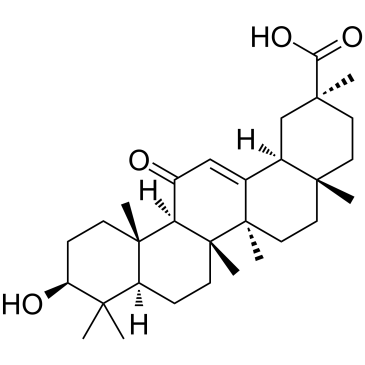18α-Glycyrrhetinic acid (Synonyms: Arthrodont, Biosone, Enoxolone, α-Glycyrrhetinic Acid, GM 1658, NSC 35347, PO 12, STX 352) |
| Catalog No.GC35061 |
18α-Glycyrrhetinic acid, a diet-derived compound, is an inhibitor of NF-kB and an activator of proteasome, which serves as pro-longevity and anti-aggregation factor in a multicellular organism.
Products are for research use only. Not for human use. We do not sell to patients.

Cas No.: 1449-05-4
Sample solution is provided at 25 µL, 10mM.
18α-Glycyrrhetinic acid, a diet-derived compound, is an inhibitor of NF-kB and an activator of proteasome, which serves as pro-longevity and anti-aggregation factor in a multicellular organism. 18α-Glycyrrhetinic acid induces apoptosis[1][2]. NF-κB Proteasome
18α-Glycyrrhetinic acid (18a-GA) markedly reduces LX-2 cell numbers by 14.8% and 31.2% after 48 h and 72 h of treatment, respectively (P< 0.05). 18α-Glycyrrhetinic acid also significantly increases the percentage of LX-2 cells in phase G0/G1 and decreases it in phase S after treated for 48 h and 72 h compare with the control group. 18α-Glycyrrhetinic acid increases apoptosis to 6.8% at 48 h, compare with control (2.5%), and at 72 h the percentages of apoptotic cells in control and the treatment groups are 3.1% and 15.6%, respectively, in LX-2 cells (P<0.01). Furthermore, 18α-Glycyrrhetinic acid induces expression of PPAR-γ and alters some cell cycle and apoptosis-related proteins. 18α-Glycyrrhetinic acid also inhibits NF-κB DNA-binding activity[1].
18α-Glycyrrhetinic acid (18α-GA) treatment significantly enhances life span of C. elegans strains with the most effective concentration being 20 μg/mL. Results reveal a significant delay of paralysis upon 18α-Glycyrrhetinic acid treatment. 18α-Glycyrrhetinic acid treatment also confers a significant reduction of Aβ deposits[2].
[1]. Zong L et al. 18α-glycyrrhetinic acid extracted from Glycyrrhiza radix inhibits proliferation and promotes apoptosis of the hepatic stellate cell line. J Dig Dis. 2013 Jun;14(6):328-36. [2]. Papaevgeniou N, et al. 18α-Glycyrrhetinic Acid Proteasome Activator Decelerates Aging and Alzheimer's Disease Progression in Caenorhabditis elegans and Neuronal Cultures. Antioxid Redox Signal. 2016 Dec 1;25(16):855-869.
Average Rating: 5 (Based on Reviews and 4 reference(s) in Google Scholar.)
GLPBIO products are for RESEARCH USE ONLY. Please make sure your review or question is research based.
Required fields are marked with *




















